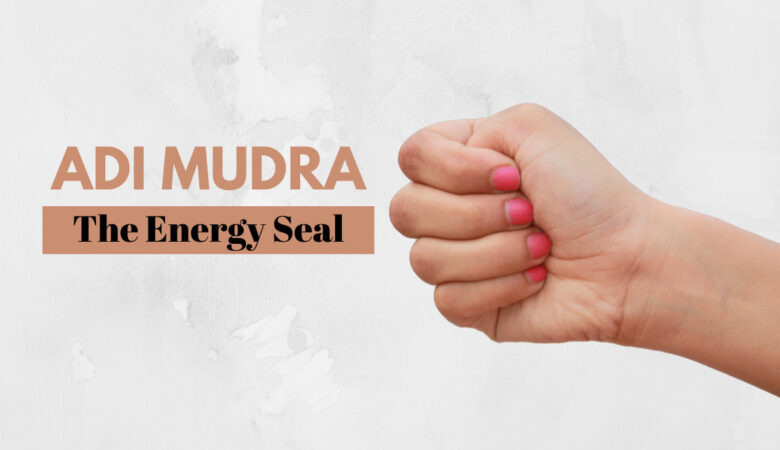In the rich tradition of yoga and meditation, mudras, symbolic hand gestures, play a powerful role in influencing the flow of energy and the state of mind. Among the most ancient and foundational of these is Adi Mudra, the “primordial gesture.” This simple yet profound hand position is deeply calming, grounding, and beneficial for enhancing breath control, meditation, and emotional balance. So, see below how to practice Adi Mudra…
Table of Contents
What is Adi Mudra?
The word “Adi” means first, original, or primordial, while “Mudra” means gesture or seal. Adi Mudra mimics the very first gesture made by a newborn baby: the thumb tucked into the palm with the fingers gently curled around it. This gesture is considered symbolic of innocence, inwardness, and a return to our natural state of balance.
Adi Mudra is not just symbolic it has physiological and psychological effects that support deep relaxation and focused awareness. It is commonly used during pranayama (breathing exercises), dhyana (meditation), and yogic relaxation techniques like Yoga Nidra.
How Long to Practice?
- Beginners: 5–7 minutes per session.
- Intermediate/Advanced: 10–30 minutes, especially during pranayama or before meditation.
- Can be practiced 1–3 times daily, preferably on an empty stomach.
How to Practice Adi Mudra: Step-by-Step
See here how to practice Adi Mudra…
1. Prepare Your Body:
Sit in a comfortable meditative posture: Sukhasana (Easy Pose), Padmasana (Lotus), or Vajrasana (Thunderbolt Pose).
If sitting on the floor is difficult, a straight-backed chair is also fine. Keep your spine erect, shoulders relaxed, and jaw unclenched.
2. Form the Mudra:
Rest your hands on your thighs or knees, palms facing upward. Gently fold your thumb into the center of your palm.
Curl the remaining four fingers over the thumb, forming a loose, relaxed fist. Turn your fists downward, allowing them to rest on your thighs comfortably.
3. Focus on Your Breath:
Close your eyes and begin slow, rhythmic breathing. Inhale deeply through your nose for a count of 4–5.
Exhale slowly through your nose for a count of 6–7, making the exhalation slightly longer than the inhalation.
As you breathe, observe the movement of your breath, allowing the body to soften and the mind to quiet down.
4. Maintain for 5–15 Minutes:
Continue this relaxed breath pattern while holding Adi Mudra. You may practice this mudra on its own, or combine it with pranayama techniques such as:
- Nadi Shodhana (alternate nostril breathing)
- Ujjayi Pranayama
- Chandra Bhedana (left nostril breathing)
Optionally, use a silent mantra like “So-Ham” to enhance focus.
Precautions and Tips:
- Do not clench the hands too tightly the grip should be relaxed and natural.
- Avoid practicing immediately after meals.
- If you experience dizziness or discomfort during breathwork, stop and resume normal breathing.
- People with serious respiratory or cardiovascular conditions should consult a healthcare provider or qualified yoga teacher before practicing extended pranayama with mudras.
Benefits of Adi Mudra:
Adi Mudra may seem simple, but it has deep physical, mental, and energetic benefits:
- Improves lung capacity and helps regulate the breath.
- Enhances oxygen intake and promotes better cellular respiration.
- Supports the parasympathetic nervous system, calming the body’s stress response.
- Can help lower blood pressure and reduce heart rate during stress.
- Induces a sense of calm and clarity.
- Eases anxiety, restlessness, and mental fatigue.
- Supports emotional balance and a meditative state of awareness.
- Encourages introspection and mindfulness.
- Grounds excess energy and promotes inward focus.
- Balances the prana (life force) and aligns it with the central channel (Sushumna Nadi).
- Opens the Ajna Chakra (third eye) and fosters intuitive insight.
Conclusion:
Adi Mudra may look like a humble gesture, but its effects are profound. By returning to this primordial hand position, we return to a place of stillness, silence, and self-awareness. In a fast-paced world, this ancient yogic tool reminds us that sometimes, the deepest transformations begin with the smallest gestures.
Whether you are a beginner in yoga or an experienced practitioner, Adi Mudra can be a powerful addition to your daily routine, anchoring you to breath, stillness, and the wisdom of the body.





